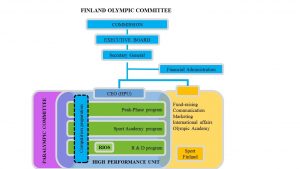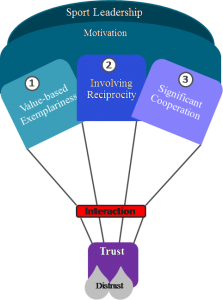What kind of leadership is the key in the success of elite sports in Finland?
The success of Finnish athletes in different sports has always had a great importance for the Finnish people and a strong impact on the national identity. Recently, this success has declined especially in the traditional sports, such as track and field, cross-country skiing and ski jumping.Therefore, the Finnish Olympic Committee (FOC) and the structure of elite sports in Finland has recently been undergoing a process of change. During this process, they have acknowledged the importance of leadership as a foundation of successful elite sport. This blog discusses the current study of these key leadership elements. The results indicate that leadership in elite sports in Finland is based on trust and driven by value-based exemplariness, reciprocity and cooperation.
Restructuring the elite sport together
The Ministry of Education established a working group in 2008 in order to restructure the organizations in elite sports in Finland. The aim for this team was to lead the elite sports process of change together with the national sport associations. The objectives were, first, to evaluate the functions of the recent elite sport system in Finland regarding the allocation of responsibilities and challenges of the international working environment and secondly, to introduce the necessary change propositions. This group finished its work at the end of 2012, and one of the outcomes was that all elite sports organizations in Finland should have a collective management system and an enriching, interactive and accomplished organizational management culture.
The main goal was to develop a distinct, centralized organization with comprehensive responsibilities. These strategic targets were put into action through three High Performance Unit programs; the Sport Academy program, the Peak-Phase program and the Research and Development program. The Sport Academy supports athletes in their paths, the Peak-Phase focuses on promoting success, and the R&D ensures the utilization of the latest research. At the center of the development of the Finnish elite sport is the athlete whose development is described by the Athlete’s Path, with its origin in the individual. The quality of the Athlete’s Path is enhanced by the seamless cooperation of the elite sports network, ambitious know-how and the developmental approach of all operators, which relies on goal-oriented passion.
Figure 1. The structure of the Finnish Olympic Committee. Source: Suomen olympiakomitea (2012) Suomalaisen huippu-urheilun muutos: Huippu-urheilun muutosryhmän raportti, p. 15. Helsinki: Printix Oy.
The vision of the FOC is: Finland – the world’s most moving sports people. In this study the main issues to learn were: What kind of leadership is needed to accomplish that vision? What are the perceptions of leadership of FOC leaders that could make the new structure function? This blog discusses the main findings related to the leadership perceptions of volunteer and employed FOC leaders.
In organizational changes, sport leadership is more important than management
In theory, we quite often distinguish the concepts of management and leadership. It is obvious that these two are “different sides of the coin”. However, this difference is not so clear in practice. In changes, such as this, it is easier to make management decision than lead people. Before introducing the most important leadership elements in elite sports in Finland, the main differences in leadership and management are explained.
Managers are mainly interested in generating order and consistency, planning, budgeting, organizing and controlling, whereas, in contrast, leaders produce change, establish direction, align people and motivate them. At present, leadership is often seen as a dynamic process in which the individuals aim at a common objective. In the Bass Handbook of Leadership (1990), Bernard and Ruth Bass define leadership as “the interaction between two or more members of a group structuring or restructuring the situation and perceptions and expectations of the members”. Leaders are agents of change and leadership occurs when one group member modifies the motivation or competencies of others in the group. It could be said that leadership is about leading different relationships.
Sports leadership in the FOC − based on trust and interaction
There are three key areas of sports leadership in the FOC which can be considered as top results of this study in terms of both organizational leadership and sporting success; value-based exemplariness, involving reciprocity and meaningful co-operation. The metaphor of “hot air balloon” is used to illustrate the main elements. What these elements have in common is that they require interaction (burner), building and maintaining trust (hold up a wicker basket) and motivating the athlete, employees and interest groups in order to achieve good results (fulfill the envelope with hot air and complete the flight).
Figure 2. The three key elements of sport leadership in Finland
Value-based exemplariness – essential prerequisites for the creation of leadership
The first element, the importance of values and exemplariness, is seen as a high priority in sport leadership amongst interviewed FOC leaders. Values are considered to be essential prerequisites for the creation of leadership. The key values are responsibility, ethicality, openness, focus on the athlete, equality, respect, appreciation, enthusiasm, joy and passion. Values are found to be everyday tools that help building the experience of “ownership” amongst the employees. Sport leadership emphasizes respect for and appreciation of the work and competence of others. Exemplariness is a value and an approach, and it can be described as a leader being present, involved in active interaction, supporting rapid change and guiding employees towards good practices. Exemplariness builds trust within the entire organization. By setting an example, a sport leader is seen to contribute to a healthy organizational culture. Leaders should adopt shared values for everyday use, internalise the value basis and crystallise it by active interaction, keep the responsibility and ethicality of operations in constant view and think about people’s strengths instead of their weaknesses.
Deepen the dialogue with employees, athletes and interest groups
Second element of the leadership perspective is involving reciprocity, which covers dialogue, the provision and reception of various kinds of feedback, encouragement, authorization, tolerance of mistakes and focus on solutions. Good dialogue within the network, in particular, generates trust. The purpose of dialogue is to create a shared vision for everyone working in a sports organization, meaning both, employees and volunteer workers. Involving people in the activities and shared decision-making contribute to motivation and commitment to the organization. The skill requirements for the Olympic Committee’s top leaders include the courage to provide critical, constructive feedback to the chairpersons of all sports regardless of their position and personality. The leader should be able to give feedback while showing appreciation of the other party, together with retaining the other party’s motivation. Nobody can grow to become a successful sport leader achieving excellent results if the organization or the leader do not accept the idea that mistakes can be made, and that they are something to be learnt from. For a sport leader, the focus on finding solutions means one-to-one dialogue as soon as a problem occurs, together with both parties giving reasons for their opinions.
Developing meaningful cooperation within the entire field of sports
Meaningful cooperation is the third of the key leadership elements. The Finnish Olympic Committee’s leaders identify their primary duties as serving the athlete and building relationships with the entire network. In developing relationships, it is important to achieve high-quality relationships, which are close and confidential. Face-to-face meetings are considered as a key to relationship development, and co-operation is the basis for determining a shared meaning and direction. The creation of leadership requires a visionary approach defining and launching a shared vision, and sport leader’s task is to ensure that the FOC promotes this vision. Co-operation at the operational and strategic level, such as business life, the world of science, the sponsors and the athletes have a significant influence on the end results. This co-operation should value the input of all parties because good sport leadership is generated in a network of actors. “You must give something first in order to receive something back” was suggested as a guiding principle for sport leaders.
Conclusion
To conclude, the Finnish Olympic Committee is under a process of change and facing challenges on both its operational and leadership levels. It is of importance to make changes in leadership in order to make the operational level function effectively. Changes in the structure and responsibilities at the operational level have already been made, but they are only the first steps in the modification process. With new aims within the organizational culture, it is important that changes in the leadership are approved in all levels of the organization. This change is only possible when the senior management of the Olympic Committee is committed to this process, ensure the compliance across the entire organization, and act as examples themselves. The FOC leaders should actively commit for sharing information and building trust in a broad network. The new leadership culture cannot be created by using the bottoms up approach, but from the top down, and develop horizontally by stressing the leadership themes mentioned above. A trusting culture and athletes with excellent results are not achieved on short term, but the change should be a long term goal.
Sami Kalliomaa, JAMK University of Applied Sciences, School of Business, Rajakatu 35, 40200, Jyväskylä, Finland, sami.kalliomaa (at) jamk.fi
Aila Ahonen, JAMK University of Applied Sciences, Sport Business School Finland, Rajakatu 35, 40200, Jyväskylä, Finland, aila.ahonen (at) jamk.fi

